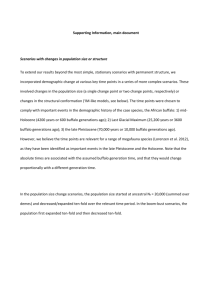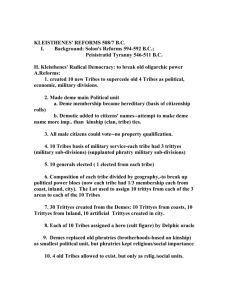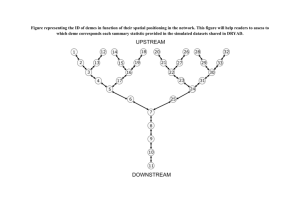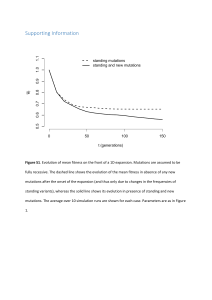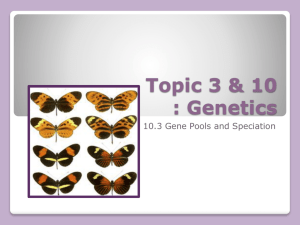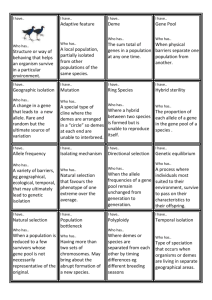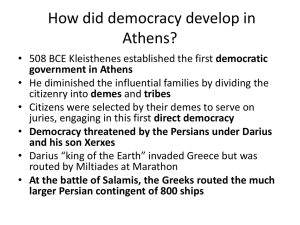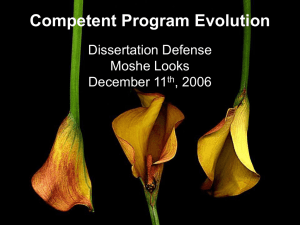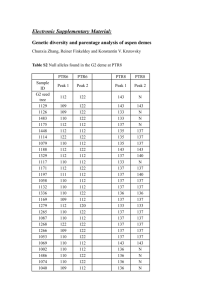STOCHASTICITY, COMPLEX SPATIAL STRUCTURE, AND THE FEASIBILITY OF THE B O’F
advertisement
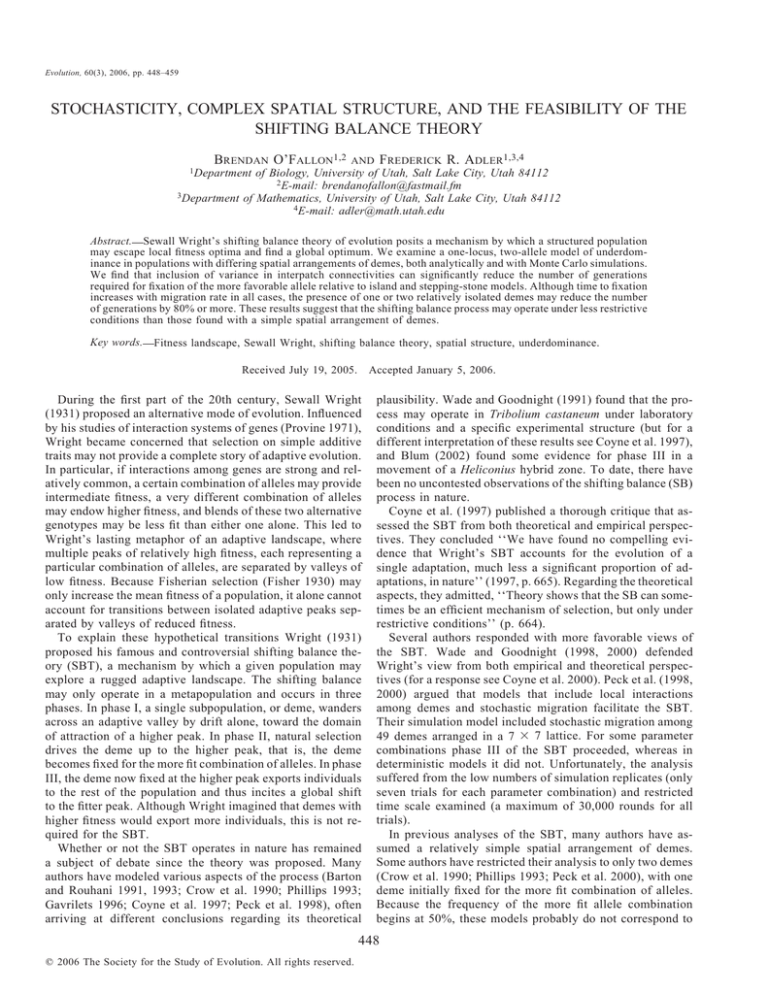
Evolution, 60(3), 2006, pp. 448–459
STOCHASTICITY, COMPLEX SPATIAL STRUCTURE, AND THE FEASIBILITY OF THE
SHIFTING BALANCE THEORY
BRENDAN O’FALLON1,2
AND
FREDERICK R. ADLER1,3,4
1 Department
of Biology, University of Utah, Salt Lake City, Utah 84112
2 E-mail: brendanofallon@fastmail.fm
3 Department of Mathematics, University of Utah, Salt Lake City, Utah 84112
4 E-mail: adler@math.utah.edu
Abstract. Sewall Wright’s shifting balance theory of evolution posits a mechanism by which a structured population
may escape local fitness optima and find a global optimum. We examine a one-locus, two-allele model of underdominance in populations with differing spatial arrangements of demes, both analytically and with Monte Carlo simulations.
We find that inclusion of variance in interpatch connectivities can significantly reduce the number of generations
required for fixation of the more favorable allele relative to island and stepping-stone models. Although time to fixation
increases with migration rate in all cases, the presence of one or two relatively isolated demes may reduce the number
of generations by 80% or more. These results suggest that the shifting balance process may operate under less restrictive
conditions than those found with a simple spatial arrangement of demes.
Key words.
Fitness landscape, Sewall Wright, shifting balance theory, spatial structure, underdominance.
Received July 19, 2005.
Accepted January 5, 2006.
During the first part of the 20th century, Sewall Wright
(1931) proposed an alternative mode of evolution. Influenced
by his studies of interaction systems of genes (Provine 1971),
Wright became concerned that selection on simple additive
traits may not provide a complete story of adaptive evolution.
In particular, if interactions among genes are strong and relatively common, a certain combination of alleles may provide
intermediate fitness, a very different combination of alleles
may endow higher fitness, and blends of these two alternative
genotypes may be less fit than either one alone. This led to
Wright’s lasting metaphor of an adaptive landscape, where
multiple peaks of relatively high fitness, each representing a
particular combination of alleles, are separated by valleys of
low fitness. Because Fisherian selection (Fisher 1930) may
only increase the mean fitness of a population, it alone cannot
account for transitions between isolated adaptive peaks separated by valleys of reduced fitness.
To explain these hypothetical transitions Wright (1931)
proposed his famous and controversial shifting balance theory (SBT), a mechanism by which a given population may
explore a rugged adaptive landscape. The shifting balance
may only operate in a metapopulation and occurs in three
phases. In phase I, a single subpopulation, or deme, wanders
across an adaptive valley by drift alone, toward the domain
of attraction of a higher peak. In phase II, natural selection
drives the deme up to the higher peak, that is, the deme
becomes fixed for the more fit combination of alleles. In phase
III, the deme now fixed at the higher peak exports individuals
to the rest of the population and thus incites a global shift
to the fitter peak. Although Wright imagined that demes with
higher fitness would export more individuals, this is not required for the SBT.
Whether or not the SBT operates in nature has remained
a subject of debate since the theory was proposed. Many
authors have modeled various aspects of the process (Barton
and Rouhani 1991, 1993; Crow et al. 1990; Phillips 1993;
Gavrilets 1996; Coyne et al. 1997; Peck et al. 1998), often
arriving at different conclusions regarding its theoretical
plausibility. Wade and Goodnight (1991) found that the process may operate in Tribolium castaneum under laboratory
conditions and a specific experimental structure (but for a
different interpretation of these results see Coyne et al. 1997),
and Blum (2002) found some evidence for phase III in a
movement of a Heliconius hybrid zone. To date, there have
been no uncontested observations of the shifting balance (SB)
process in nature.
Coyne et al. (1997) published a thorough critique that assessed the SBT from both theoretical and empirical perspectives. They concluded ‘‘We have found no compelling evidence that Wright’s SBT accounts for the evolution of a
single adaptation, much less a significant proportion of adaptations, in nature’’ (1997, p. 665). Regarding the theoretical
aspects, they admitted, ‘‘Theory shows that the SB can sometimes be an efficient mechanism of selection, but only under
restrictive conditions’’ (p. 664).
Several authors responded with more favorable views of
the SBT. Wade and Goodnight (1998, 2000) defended
Wright’s view from both empirical and theoretical perspectives (for a response see Coyne et al. 2000). Peck et al. (1998,
2000) argued that models that include local interactions
among demes and stochastic migration facilitate the SBT.
Their simulation model included stochastic migration among
49 demes arranged in a 7 3 7 lattice. For some parameter
combinations phase III of the SBT proceeded, whereas in
deterministic models it did not. Unfortunately, the analysis
suffered from the low numbers of simulation replicates (only
seven trials for each parameter combination) and restricted
time scale examined (a maximum of 30,000 rounds for all
trials).
In previous analyses of the SBT, many authors have assumed a relatively simple spatial arrangement of demes.
Some authors have restricted their analysis to only two demes
(Crow et al. 1990; Phillips 1993; Peck et al. 2000), with one
deme initially fixed for the more fit combination of alleles.
Because the frequency of the more fit allele combination
begins at 50%, these models probably do not correspond to
448
q 2006 The Society for the Study of Evolution. All rights reserved.
449
FEASIBILITY OF THE SHIFTING BALANCE
TABLE 1.
Symbol
s
N
mij
m
D
m
d e, d i
k
g
Parameters and values used in the simulation and mathematical model.
Values
0.01, 0.05, 0.1
50, 100, 200
many (0.0–0.05)
0.000–0.035
10, 20, 40
0.0001
0, 1, 2, 4
0, 2, 3, 6
0, 1, 5
Description
relative advantage of AA and disadvantage of Aa
number of individuals per deme
per individual probability of migration from deme j to deme i
mean global migration rate
number of demes
two-way mutation rate
effect of isolation of demes on export and import (in nonuniform export MDK model)
number of isolated demes (in MDK model)
strength of interdeme selection, relative to individual selection
SB as it may exist in the natural world (see Gavrilets 1996).
In other cases either an island (Lande 1985; Barton and Rouhani 1993) or a one- or two-dimensional stepping-stone (Barton and Rouhani 1991; Gavrilets 1996) model was used. Under these assumptions and others regarding the strength of
selection and probability of migration, analytic formulas for
the distribution of demic states, probabilites of fixation, and
times to fixation can sometimes be achieved (Lande 1979,
1985; Barton and Rouhani 1993). Several authors have noted
that fixation of underdominant mutations is more likely if the
initially fixed deme is at the edge of the world of demes
(Boorman and Levitt 1980; Gavrilets 1996) or in a region of
low neighborhood size (Barton and Rouhani 1991), but no
studies have explicitly examined the impact of spatial complexity on the feasibility of the SBT.
In this paper we develop and analyze a model that relaxes
the assumptions of simple population structure and determinism. Our goals are twofold. First, we build upon Peck et
al.’s (1998) results and present a thorough investigation of
the SBT in a purely stochastic world. Second, we relax the
assumption of simple population structure, defined as zero
variance in interdeme connectivity, and compare the efficiency of island and stepping-stone models to both random
and clumped distributions of demes. We present simulations
and a mathematical approximation. The model is general
enough, in principle, to incorporate any distribution of interpatch connectivities, as well as all three phases of the
process.
METHODS
We examine a one-locus, two-allele model with heterozygote disadvantage. The fitness of an aa individual is one,
the fitness of the heterozygote is 1 2 s, and the fitness of the
AA homozygote is 1 1 s (see Table 1 for a list of parameters
used).
The Simulation
The simulation takes place in discrete generations, with each
generation involving three independent events; mutation, reproduction, and migration. The number of individuals of each
genotype in each deme is an explicit variable in this individualbased model. Mutation takes place each round, with each allele
mutating to the other type with probability m.
Prior to selection, individuals are assumed to mate randomly and produce a large number of zygotes in HardyWeinberg proportions. To determine the composition of the
population in the next generation, zygotes are sampled with
probabilities determined by genotypic fitnesses; for example,
the probability of selecting an AA individual is p2(1 1 s)/
W(p), where p is the frequency of the A allele and W(p) is
the mean fitness of the population. Zygotes are sampled until
the population contains exactly N individuals.
Migration takes place after mutation and selection in every
generation. Given a patch connectivity mij, a group of migrants was created that contained a Poisson distributed number of individuals with mean Nmij. Individuals were randomly
removed from the source deme, independent of genotype.
The individuals in the migrant group were then placed in the
destination deme.
The Migration Model
Our goal was to render migration in a manner more similar
to nature than island or stepping-stone models. Given an
arbitrary distribution of demes on the unit torus, a matrix of
connectivities between all demes was constructed such that
the connectedness of demes i and j was given by cij 5 (d2ij
1 0.01)21, where dij is the distance separating the demes. We
assumed a fixed global per capita migration probability, m,
such that each individual has probability m of migrating in
a given generation, irrespective of the distances to nearby
demes. To accomplish this, the rows of the matrix of deme
connectivities were divided by their average, divided again
by the number of demes in the metapopulation, and then
multiplied by m. Thus, the sum of each row in the matrix
was m (ignoring the diagonal entries). The sums of the columns of the matrix, which represent the likelihood of a deme
to receive immigrants, were left to vary. Because the size of
each deme was held constant at N, each deme exports on
average Nm individuals per round, but demes vary in how
many individuals they receive each round.
Generating Patchy Distributions of Demes
In addition to assessing the effect of spatial distributions
where the location of each deme was selected independently
(random distributions), we also sought to examine clumpy
patterns, where the variance in deme connectivity was increased. Clumpy patterns were generated following Adler and
Nuernberger (1994). We first define a clumpiness index, Gi,
for each deme i such that
1
1
Gi 5
.
(1)
D 2 1 i±j 0.01 1 d ij2
O
450
B. O’FALLON AND F. R. ADLER
FIG. 1. (a) In the simulation, each deme has a large number of possible states (proportions of the A allele, represented by black area),
and every location is unique. To simplify calculations, we make two assumptions: (b) every deme is always fixed for one or the other
allele, and (c) only two locations exist, clumped and isolated. Migration probability between two demes is indicated by the weight of
the line connecting them.
During each iteration of the algorithm, a new potential
location is selected on the torus for every deme. The probability of moving a deme to this new location is an increasing
linear function of the G-value at the new point. The procedure
is repeated until patterns of desired clumpiness are obtained.
Patterns can be described by the mean G over all demes.
Random patterns produced an average G of near 11. Patterns
that match our intuitive notion of clumpy generally have a
G-value greater than 20. In addition to random patterns, we
examined patterns that had an average G of 20 or 25. G was
positively correlated with variance among column sums of
the matrix of deme connectivities in the range of indices
considered (correlation coefficient ø 0.73). Demes were not
moved during any simulation replicate, but new patterns were
generated for each replicate for the random and clumped
patterns.
A Markov Chain Approximation
Because our simulation has a finite number of states and
probabilities of transitions between these states are, in principle, calculable, a single Markov chain can describe the
entire system. However, the number of states is too large (2N
1 1)D11 to analyze, and thus we make two assumptions to
simplify the calculations. First, we assume the demes spend
their time fixed for one or the other allele. This reduces the
number of states for a single deme from 2N 1 1 to 2. Second,
we allow only two possible connectivities of demes, clumped
and isolated. This assumption allows us to examine the effects
of variance in deme connectivity, but not the importance of
local effects because demes in each location class are identical. Because all demes in a given location receive the same
number of immigrants (on average), the number of possible
states for the entire metapopulation is greatly reduced (see
Fig. 1).
We first calculate the probability that a single deme with
j A alleles (and 2N 2 j a alleles) will have i A alleles after
one generation. Each generation consists of one round of of
mutation, selection, and given immigration rates of mA A
alleles and ma a alleles. Using this information, we can calculate the probability that a deme fixed for a crosses the
adaptive valley after a certain number of generations, and
likewise for the transition from a to A. Because these probabilities depend on the number of A and a alleles entering
the deme (denoted by mA and ma, respectively), we express
them as functions: P(mA, ma) for the transition from fixed for
a to fixed for A and Q(mA, ma) for the reverse transition.
Second, we compute mA and ma for a given distribution of
demes and deme states, and using P(mA, ma) and Q(mA, ma)
we calculate the probability that a metapopulation with j
demes fixed for A will switch to having i demes fixed for A.
We do this first for an island model and then extend our
analysis to a metapopulation with two types of demes, isolated and clumped.
Modeling dynamics within demes
The mathematical model begins with a description of the
dynamics within a particular deme. Because the number of
possible allelic states is not too large and the simulations
take place in discrete rounds, a Markov chain approach may
be used to obtain a probability distribution for the state of a
given deme at any time. Let the states of the system be the
number of A alleles present; there are then 2N 1 1 possible
states. The probability that a deme in state j in one round
will be in state i the next round, Tij, is a combination of three
independent factors, mutation, migration, and selection.
Thus, the matrix of transition probabilities may be decomposed into three matrices, one for each factor.
Let U be the matrix describing transition probabilities due
to mutation alone. Each element, Uij, may be expressed as
the following:
U ij 5
O B( j 2 i 1 k, j, m)B(k, 2N 2 j, m),
2N
k50
where B is the binomial probability density function
(2)
451
FEASIBILITY OF THE SHIFTING BALANCE
B(m, n, p) 5
1m2 p
n
m
(1 2 p) n2m .
(3)
The first function in the sum represents the probability that
j 2 i 1 k of the j A alleles present will mutate to a, the last
function the probability that k of the 2N 2 j a alleles will
mutate to A. In the actual calculations, we ignored the possibility that mutation changed the number of A alleles in a
deme by more than 10 in any given generation.
The matrix of transition probabilities due to selection, S, is
[ ][
1 2
i
]
pW ( p)
2N pW A ( p)
S ij 5
12 ¯A
¯ p)
i
W(
W( p)
2N2i
,
(4)
where p 5 j/2N.
Finally, for a known probability of arrival of A alleles and
a alleles, the matrix that describes transitions due to immigration, R, can be found by noting that the number of A
alleles that are replaced by an arrival of k individuals is a
hypergeometric random variable with parameters 2N, j, and
k. Because arrivals of both types of alleles are approximately
Poisson distributed (we use the Poisson approximation of the
binomial; Adler 2005), each element in the matrix is the sum
of a number of alternative probabilities:
R ij 5
O O H(2N, k 1 l, j, j 2 i 1 k)
`
`
k50 l50
3 M AA (k, m AA )M aa (l, m aa ),
(5)
where k and l index the number of arriving A and a alleles,
H is the hypergeometric density function, MAA(k, mAA) represents the probability of receiving k A alleles given a Poisson-distributed flow of AA individuals with mean mAA, and
similarly for Maa(l, maa). Given these three matrices, their
product T 5 RSU gives the matrix of transition probabilities
for allelic states within a single deme. T may then be used
to calculate the probability of transition from the fixed for A
state to any other state, and the reverse, given a known immigration rate of A and a alleles.
Modeling dynamics between demes
To apply the within-deme processes to the entire metapopulation, we assume that demes are always either fixed for
A or a. We call these states shifted and unshifted, or simply
on or off, respectively. Although this assumption appears to
contradict our earlier description of within-deme dynamics,
an explicit within-deme process is still necessary to compute
the P and Q functions described above. Thus, we assume that
selection is strong enough that few demes have intermediate
fitness, which is consistent with Wright’s idea of an adaptive
valley that is difficult to cross by drift alone. We begin by
considering the probability that a patch fixed for the a allele
and receiving a Poisson-distributed flow of mA AA individuals
and ma aa individuals per generation crosses the valley in a
certain number of rounds, say r. This may be found by multiplying a vector with all probability in the 0 state by T(mA,
ma)r, and then taking the sum of v elements at the end of the
vector that correspond to fixation for the A allele, where v
depends on s in general, but was taken to be 100 for the
results shown here. Repeating this process for a wide range
of mA and ma combinations produces a matrix of probabilities
of transitions to the shifted state. Interpolating the values in
this matrix yields a function that describes the probability of
transition to the shifted state given a certain flow of A and
a alleles, for a particular number of generations, which we
call P(mA, ma). Put simply, P(mA, ma) describes the probability that a deme fixed for a and receiving a certain flow of
AA and aa individuals becomes fixed for A in r generations.
Similarly, the function Q(mA, ma) describes the probability
of transition from the shifted to the unshifted state. For this
analysis we chose r 5 100 generations, approximately the
time to fixation of an A allele, conditional on fixation.
Given the functions P(mA, ma) and Q(mA, ma), it is possible
to calculate the probability of changes of state for the entire
metapopulation. We begin here with the island arrangement
and then expand our method to a pseudospatial model that
approximates the more complex spatial structure used in the
simulations.
For an island arrangement of demes, using our assumption
that demes are always fixed for either one or the other allele,
the entire metapopulation has only D 1 1 states, where D is
the number of demes. If there are j demes fixed for A, and
each of these exports m A alleles each round, then all demes
experience a Poisson-distributed flow of jm AA individuals
and (D 2 j)m aa individuals (from the remaining, unshifted
demes) each generation. The probability of an unshifted deme
becoming shifted is then P(jm, (D 2 j)m), and the probability
of a shifted deme becoming unshifted is Q(jm, (D 2 j)m).
Thus the total number of demes that switch from unshifted
to shifted is a binomial random variable with parameters D
2 j and P(jm, (D 2 j)m) and the number of off demes that
switch to on is also binomially distributed but with parameters j and Q(jm, (D 2 j)m). Implicit in this framework is
the assumption that demes shift only once during the r generations. This assumption is accurate for phases I and II of
the process, because shifts are infrequent during this period,
but potentially inaccurate during the midst of phase III. Nonetheless, the approximation appears robust (see Comparison
of Simulation and Mathematical Results, below).
To compute the probability that a world with j demes on
becomes a world with i demes on, we must sum over a number
of different possibilities that represent different paths from
j to i. For instance, if j is 3 and i is 5, we must include the
probability that two additional demes turned on and zero
turned off, as well as the probabilities that three demes turned
on and one turned off and that four turned on and two turned
off, and so on.
Putting all this together yields and expression for Vij:
V ij 5
O 1D k2 j2 P
D
k50
3
k
(1 2 P) D2j2k
1k 2 i 1 j2 Q
j
k2i1j
(1 2 Q) i2k .
(6)
where the arguments to the P and Q functions are (jm, (D 2
j)m).
A Pseudospatial Model
In principle, the above method could be applied to metapopulations of arbitrary spatial structure and number of
452
B. O’FALLON AND F. R. ADLER
demes. However, even with the two state approximation, the
number of possible states is 2D11 if every deme is unique.
To further reduce the number of possible states, we constructed a model that captures some of the elements of complex spatial structure, namely variance in immigration potential among demes, but that uses only two types of demes.
In this construction, we imagine k of the D demes are isolated
by a factor of d, such that immigration to these demes, given
a particular m, is reduced to m(1 2 d/k). To ensure that the
global average migration rate remains equal to m, the remaining D 2 k demes experience increased migration of m(1
1 d/(D 2 k)). The parameter d describes the degree of isolation of the k demes and ranges between zero (no isolation
of demes, which reduces to the island model) and k (demes
are so isolated they receive no immigrants). We refer to this
as the MDK model; often we write MDK(d, k) to indicate
precise values of d and k used for a given calculation. It is
important to note that varying d does not affect the mean
migration rate in the metapopulation, it increases only the
variance in deme connectivity.
To facilitate comparison to the spatial models, it would be
convenient to calculate a G-value for an arbitrary MDK model. Unfortunately, an unambiguous G cannot be calculated
given an arbitrary matrix of connectivities because information about the absolute distances is lost when distances
are converted to connectivities. The most accurate comparison between the MDK and spatial models is the coefficient
of variation among column sums of the connectivity matrix,
which is a more direct measure of variation in migration
probabilities.
The MDK model has (k 1 1)(D 2 k 1 1) possible states,
and each state represents a unique number of shifted, isolated
demes and shifted, nonisolated demes. The calculations for
the transition matrix are similar to those for the island model,
but both types of demes must be treated separately. For simplicity, we refer to k demes that receive fewer migrants as
the isolated demes and the remainder as the clumped demes.
For a given state index, let ji indicate the number of isolated
demes on and jc indicate the number of clumped demes on.
The number of isolated demes that switch from on to off in
a given number of generations is assumed to be independent
of the number of clumped demes that switch. Because all
isolated demes are identical in terms of the expected number
of migrants they receive and all demes are identical in terms
of the migrants they export, a simple expression may be
written for the probability of transitions between states of
isolated demes alone. By definition, all isolated demes receive, on average, m(1 2 d/k) individuals per round. Given
jc 1 ji shifted demes in a given generation (and D 2 jc 2 ji
unshifted demes), every isolated deme experiences a mean
flow of
1
m i,A 5 ( j c 1 j i )m 1 2
d
k
2
AA individuals per round and
1
m i,a 5 (D 2 j c 2 j i )m 1 2
d
k
2
aa individuals per round. Thus, every isolated deme that is
off has independent probability P(mi,A, mi,a) of turning on.
Similarly, every isolated deme that is on has an independent
probability Q(mi,A, mi,a) of turning off.
As with the island model, the total number of isolated
shifted demes that unshift and isolated unshifted demes that
shift is the the sum of two binomial random variables with
parameters P(mi,A, mi,a) and Q(mi,A, mi,a). To find the probability of transition to a particular number of isolated shifted
demes, ii, we sum over all probabilities of transitions that
lead to ii isolated shifted demes from ji isolated shifted demes.
The total probability that a world with ji isolated shifted
demes and jc clumped shifted demes transitions to a world
with ii isolated shifted demes is given by:
Di 5
O 1k 2l j 2 P(m
k
c
l50
i,A ,
m i,a ) l
3 [1 2 P(m i,A , m i,a )] k2j c2l
3
1l 2 j 2 i2 Q(m
ji
i,A ,
m i,a ) l2j i2i
i
3 [1 2 Q(m i,A , m i,a )] i2l .
(7)
where the arguments to P and Q are (mi,A, mi,a).
Similar reasoning follows for the probability of transition
to a given number clumped demes. In this case mc,A and mc,a
are given by
1
m c,A 5 ( j c 1 j i )m 1 1
2
d
D2k
1
m c,a 5 (D 2 j c 2 j i )m 1 1
and
2
d
,
D2k
respectively. Multiplying the probabilities for the transitions
between numbers of isolated shifted demes and numbers of
clumped shifted demes, and taking care to index properly,
yields a matrix with (k 1 1)(D 2 k 1 1) rows and columns
that describes the probability of stochastic shifts between all
possible states of the metapopulation.
Once this matrix has been calculated, a straightforward
procedure leads to calculation of the expected first passage
time (FPT; Bhat and Miller 2002), the expected number of
rounds until the process, initially in state i, reaches state j
for the first time. We are particularly interested in the expected number of rounds for the process to proceed from a
state with zero shifted demes to a state with D shifted demes.
This was taken to be a combined measure of the efficiency
of all three phases of the SBT.
Identification of Steady States
A deterministic approximation of this process may be obtained by considering x, the fraction of demes that are shifted
at a given time. If the total number of demes is large, we
may ignore stochastic fluctuations in the numbers of shifted
demes and focus, for the moment, on identifying equilibria.
The change in x after one r-round time step may be found
by using the functions P(mA, ma) and Q(mA, ma). In an island
model, all demes export and receive the same number of
migrants, m. If x is the fraction of shifted demes, all demes
receive xm AA individuals (as a fraction of total deme size)
453
FEASIBILITY OF THE SHIFTING BALANCE
and (1 2 x)m aa individuals. After one time step, the fraction
of shifted demes is the sum of those shifted demes that did
not unshift and the unshifted demes that did shift:
x9 5 x{1 2 Q(xm, (1 2 x)m)}
1 (1 2 x)P(xm, (1 2 x)m).
(8)
Equilibria occur where x9 5 x, and are obtained by setting
xeq 5 x9 5 x and solving for xeq. Doing so yields:
x eq 5
P(xm, (1 2 x)m)
.
P(xm, (1 2 x)m) 1 Q(xm, (1 2 x)m)
(9)
Similar calculations can be carried out for the MDK model,
but the system will have two state variables, one for isolated
demes and another for clumped demes. Import to isolated
demes is decreased by a factor of (1 2 d/k), and import to
clumped demes is increased by a factor of [1 1 d/(D 2 k)].
Treating m as a bifurcation parameter, we can asses the
number, location, and stability of equilibria for different levels of migration. This procedure is a discrete-time analogue
of similar calculations carried out by Barton and Rouhani
(1993), who used Wright’s formula and simplifications thereof to approximate the distribution of demic states. We further
simplify and assume that demic states are Bernoulli random
variables, with probabilities of transition given by P and Q
and the state of the migrant pool. Our method also takes into
account the history of a deme in question, because migration
events several generations ago affect P and Q, and thus may
alter the probability of a shift. This approach is nearly identical to Hanski’s incidence function model of patch occupancy in spatially realistic metapopulations (Hanski 1994),
with P and Q describing the colonization and extinction probabilities of the A allele.
In a diffusion analysis the two quantities of interest are M,
the expected change in gene frequency as a function of the
current frequency, and V, the variance of that change (Ewens
1979). Modifying equation (8) by subtracting the current allele frequency x yields an expected change as a function of
the present state. The variance in this quantity is given by
the sum of two binomial random variables, the number of
demes switching from fixed for A to fixed for a, and vice
versa. The two random quantities are independent by assumption. For the island model, the variance is given by:
V5
P(1 2 P)
Q(1 2 Q)
1
,
D2k
k
(10)
where we have omitted the dependence on x and m for clarity.
Although M and V in principle may be used to calculate, for
example, a global probability of fixation, the complicated
form of P and Q prohibit a simple expression for this and
other quantities of interest. If simple expressions for P and
Q can be found, then the methods of diffusion analysis may
allow for an analytic approximation of times to and probabilities of fixation, as well as an expression for the critical
migration rate.
Alternative Migration Models
Our previous assumption of uniform export from all demes
may in some cases be unrealistic. Here we relax this previous
assumption and examine models that include isolation by
distance for both import and export. We can also investigate
the importance of Wright’s original idea that SB is driven
by greater export from demes with higher mean fitness.
To include differential export, we assume that export is
decreased by distance in exactly the same fashion as import.
In the MDK model, this means that isolated demes export
Nm(1 2 d/k) individuals on average and clumped demes export Nm(1 1 d/(D 2 k)) individuals, hence average export
remains constant at Nm for any choice of d or k. Because
distance may have different effects on the export and import
of individuals from the demes, we separate the degree of
isolation of export from import by writing de and di, respectively. Given this description, the average flow of individuals
from an isolated deme to another isolated deme is Nm(1 2
di/k)(1 2 de/k), and the flow from clumped demes to isolated
demes is Nm(1 2 di/k)[1 1 de/(D 2 k)]. Flow into clumped
demes follows similarly. The case de 5 0 reduces to the
uniform export case where distance has no effect on export,
and de 5 di means distance has similar effects on import and
export. We are particularly interested in the case where individuals have some innate tendency to leave a deme, but
the destination is influenced only by distance to that deme,
which implies de , di.
We also examined the impact of differential export from
demes of higher mean fitness. We begin by introducing a
new parameter, g, which describes the degree to which the
mean fitness of a deme affects its export, and thus can be
thought of as the parameter that translates the individual selection coefficient, s, to the group selection coefficient. Export from the deme is given by m[1 1 g (W 2 1)], where W
is the mean fitness of the deme. g 5 0 reduces to the basic
model of uniform export described above, g 5 1 implies that
export is altered by a factor of W, so a deme fixed for a
exports on average Nm individuals, but a deme fixed for A
exports Nm(1 1 s) on average.
RESULTS
Identification of Equilibria
The number and location of equilibria of the deterministic
approximation (9) are presented in Figure 2. With m less than
about 0.0125, the metapopulation progresses to the single
stable equilibrium at the top of the figure, which corresponds
to global fixation for A, regardless of population structure.
However, as m increases above 0.0125 in the island model
(Fig. 2a), the system undergoes a saddle-node bifurcation and
a new pair of equilibria appears. The new stable equilibrium
corresponds to a state with nearly zero shifted demes for all
levels of m. The distance between the new stable and unstable
manifolds corresponds to the level of difficulty of stochastic
transitions between the two stable equilibria and increases
with m. These results are qualitatively similar to those presented by Barton and Rouhani (1991, 1993), who also found
deterministic progression of the SBT for low m and two stable
equilibria for higher m.
For the MDK model there are two sets of equilibria, one
for the isolated demes and another for the clumped demes
(Figures 2b, 2c). As isolation of the k demes increases the
bifurcation point associated with these demes moves right,
454
B. O’FALLON AND F. R. ADLER
FIG. 2. Bifurcation diagram of equilibria of (a) an island, (b) MDK(1, 3), and (c) MDK(1.5, 3) (see text for explanation). Black lines
correspond to equilibria for the high-import demes, gray lines are equilibria for the low-import demes. A stable equilibrium always exists
at x ù 1, which corresponds to near global fixation for the beneficial allele A. As m increases, the system undergoes a saddle-node
bifurcation and new equilibria appear; a stable manifold that corresponds to near global fixation for the a allele and an unstable manifold
that separates the two stable states.
indicating that the isolated demes move to the fixed for A
state deterministically for a greater range of migration rates.
The manifold for the clumped demes is relatively unaffected
by the presence of isolated demes. For intermediate m, two
outcomes are possible: the population may remain polymorphic with the isolated demes fixed for A while the clumped
demes remain at a, or the presence of the isolated fixed demes
may drag the clumped demes across the barrier and to the
upper manifold.
Simulation Results for Differing Spatial Structures
To examine the effect of the spatial arrangement of demes,
we compared the FPT observed for the island model at a
variety of migration rates to the FPT observed for random,
clumped, and the MDK pseudospatial model used in the
mathematical analysis. The MDK model examined had three
isolated demes, and each deme was isolated by a factor of
2/3 (k 5 3, d 5 2), so that they received about one-third of
the immigration of the clumped demes. The mean FPT of 50
simulation replicates for all spatial arrangements is plotted
in Figure 3. A new pattern was generated for every replicate
of every simulation where appropriate, and each replicate was
run for a maximum of 107 generations. We show here the
results for s 5 0.05, but qualitatively similar results occur
for s 5 0.01 and s 5 0.1 (results not shown). At higher
migration rates for some spatial patterns (island and twodimensional stepping-stone), the FPT was so great that few
or no replicates reached global fixation before the maximum
number of generations; this is indicated by a dotted line leading to the top of the figure.
Figure 3 demonstrates that, for relatively low migration
rate (below 0.0125), the spatial arrangement of demes has
little effect. Relatively infrequent migration (m 5 0.001) decreases FPT substantially when compared to the m 5 0 case,
and FPT increases uniformly as m increases beyond 0.005.
All replicates of all patterns proceed through the three phases,
reaching global fixation for the A allele in several thousand
generations. This is consistent with the result from the deterministic analysis where, for low m, the process proceeds
to the single stable state with all demes fixed for A. The value
of m that yields that smallest FPT, and hence at which the
entire shifting balance process operates most efficiently, is
found at an intermediate value of 0.005 (Nm 5 0.5).
At higher migration rates, spatial structure has a profound
effect. A random arrangement of demes, where this effect is
slightest, has a mean FPT of 356,000 generations at a migration rate of m 5 0.015, while the island model has a mean
of greater than 107 generations. The two-dimensional stepping-stone model yields similar results to the random arrangement. Structures that incorporate more variance in deme
connectivity (MDK and clumped) increase this effect, extending the range of migration rates at which the shifting
balance proceeds by a factor of two or three.
The MDK(2,3) pattern appeared to be intermediate when
compared with the two clumpy patterns; for most migration
rates it yielded a mean FPT greater than clumped 25 and less
than clumped 20. Interestingly, if the coefficient of variation
in column sums of the migration matrix is taken to be a
measure of the clumpiness of the migration probabilities, then
the MDK(2,3) model appears slightly less clumpy than do
the other clumpy patterns (CV for clumped 20 ø 0.325,
MDK[2,3] ø 0.30, random ø 0.21), and the intermediate
result may be an artifact of sampling error. Nonetheless, this
finding suggests that this relatively simple, pseudospatial pattern captures the important effects of complex spatial structure, and in later analyses we take the MDK pattern to be a
surrogate for more realistic structure.
Comparison of Simulation and Mathematical Results
The calculated FPT and simulated FPT (with sample standard deviation) for the island and MDK models, for a variety
of number of demes (D 5 10, 20, 40, holding the total number
of individuals, ND, constant at 2000), are compared in Figures 4a–c. The mathematical approximation works well for
a range of migration rates, although it yields too high an
estimate for the m 5 0 case and becomes more accurate as
the number of demes increases and the number of individuals
per deme decreases. This last is an expected consequence of
FEASIBILITY OF THE SHIFTING BALANCE
455
FIG. 3. The mean number of rounds taken for the simulation to progress from a state with all demes fixed for a to a state where all
demes have p . 0.90 (the first passage time), plotted as a function of the mean migration rate (m). The dotted lines indicate a very large
number of generations (greater than 10 7, the maximum number of rounds in the simulation) for the island, random, and two-dimensional
stepping-stone models.
FIG. 4. Comparison of simulated and calculated first passage time for island and MDK models, for different numbers of demes: (a) D
5 10, N 5 200, MDK(2,1); (b) D 5 20, N 5 100, MDK(2,3); (c) D 5 40, N 5 50, MDK(4,6). The dotted line indicates a large first
passage time for the simulation runs, with a mean greater than the maximum number of generations allowed in the simulation (10 7). As
the number of individuals per deme decreases, the accuracy of the approximations improves.
456
B. O’FALLON AND F. R. ADLER
FIG. 5. Calculated first passage times (FPT) for models of differential export, for D 5 20, s 5 0.05, N 5 100. (a) Decreasing export
as a function of deme isolation, for different levels of the effect of isolation (de). (b) Interdemic selection model, various population
structures and levels of between-deme selection ( g). Simulations match both mathematical models well (results not shown).
the fact that larger demes are less likely to be fixed for one
allele or another for a given Ns.
Alternative Export Models
Figures 5a,b demonstrate the effects of decreased export
of individuals due to isolation for a model with D 5 20, s
5 0.05, and N 5 100, as predicted by the Markov chain
model. Results for the island model and uniform export
MDK(2,3) model are shown for comparison. Increasing di
from zero (the uniform export case) to de significantly increases the first passage time, though in all cases it remains
an order of magnitude or more below the island case. In the
interdemic selection model, it is apparent that increasing spatial complexity has a much greater effect on first passage
times than does increasing g, even when the new allele has
a much greater effect on interdeme fitness than individual
fitness.
The Effects of Increasing Isolation of Demes
In the simulations we examine only a few versions of the
MDK model, MDK(4,6), MDK(2,3), and MDK(2,1) (for D
5 40, 20, and 10, respectively). To further assess the effect
of both the number of isolated demes, as well as the degree
of isolation, we plot the calculated FPT relative to the island
model, for a given number of isolated demes (k), as a function
of the degree of isolation of those demes (d/k), for m 5 0.005,
m 5 0.015, and m 5 0.025 (Fig. 6), for Ns 5 5, D 5 20,
and N 5 100. At m 5 0.005 increasing d and k increases the
FPT, presumably because at lower migration rates in phases
I and II are likely to occur in a clumped deme, and the new
allele spreads more slowly to the isolated demes. In the most
extreme case, FPT was increased from 25,000 generations to
41,000 generations. At higher migration rates, increasing d
and k decreases the FPT. Even a small number of isolated
demes (two of 20), with a modest degree of isolation (the
two demes receive half of the immigrants of other demes),
reduced the FPT by over 80% relative to the island model
in the m 5 0.015 case and by over three orders of magnitude
in the m 5 0.025 case. The presence of a single isolated
deme, if isolated by a great enough degree, can reduce the
expected FPT by over 90%. However, because absolute FPT
increases with migration rate in all models, at some point the
difference between island and more complex models is
moot—the process always takes so long that our assumptions
of constant selection pressure, migration regime, and population size are no longer tenable.
DISCUSSION
Our results indicate that more complex forms of spatial
structure, particularly those that increase the variance in interdeme connectivity, facilitate SB relative to island models.
The introduction of even a modest number of isolated demes,
one or two demes in a world of 20, may reduce the time
taken for all demes to reach the more fit peak by an order of
magnitude or more. The mechanism is straightforward. Isolated demes are more likely to wander across an adaptive
valley because they receive fewer wild-type immigrants that
tend to push demes back to the original peak. Once shifted
to the more-fit peak, isolated demes are more difficult to
unshift (again, because they receive fewer immigrants) and,
hence, are more likely to induce a global peak shift.
The simulations and mathematics presented here relax
some assumptions of earlier models. First, we examine more
than two demes. Two-deme models, though presented as a
representation of a single step in phase III, are inadequate
for several reasons. Such models implicitly assume either a
one-dimensional stepping-stone arrangement of demes or a
global frequency of 50% for the more fit combination of
alleles, both of which strongly bias results in favor of the
SBT. Often, unidirectional migration is assumed, which fur-
FEASIBILITY OF THE SHIFTING BALANCE
457
FIG. 6. (a) The decrease in calculated first passage time (FPT) relative to an island model (d 5 0), as the relative isolation of small
numbers of demes increases, plotted for k 5 1–4, m 5 0.005. (b) Same as above, but for m 5 0.015; (c) m 5 0.025. Small numbers of
isolated demes can substantially reduce the time taken to reach global fixation for the beneficial allele; this effect increases with increasing
migration rate.
ther dissociates these models from reality (for further discussion see Gavrilets 1996). Second, our model assumes both
stochastic migration between demes and stochastic change
of gene frequencies within demes, factors Wright thought to
be integral to the process. Third, we examine all three phases
of the process together. In addition to being a more complete
representation of the SBT, in our analysis the location of the
deme that undergoes phases I and II has a significant effect
on the probability of phase III proceeding. Also, the total
number of generations taken to reach global fixation for the
more fit peak is highly dependent on the amount of time
spent waiting for phases I and II, and our results thus allow
for more precise estimation of the actual time scale. Finally,
we compare spatial arrangements of demes that incorporate
variance in interpatch connectivity.
It is interesting to compare models of this sort with the
two-deme stochastic model presented by Peck et al. (2000),
which explicitly compared the likelihoods of phase III proceeding under alternative assumptions of deterministic and
stochastic migration. In their model, migration was one-way
from the deme fixed for AA. Phase III failed at low Nm because too few immigrants arrived to shift the less-fit deme
in the time constraints of the model. Our results provide a
different view of the process, where increasing migration
decreases the likelihood of SB, because single demes that
drift to fixation are likely to be unshifted rapidly by immigration of aa individuals.
Our results build upon those of Barton and Rouhani (1991,
1993). Barton and Rouhani (1991) examine a two-dimensional stepping-stone model with the restriction s K m K
sn2, with n the number of demes along one dimension of the
lattice. With the assumption of large m, they found deterministic stable equilibria at all and no demes shifted at every
m, separated by an unstable manifold; they also found an
optimal neighborhood size for the probability of fixation of
a new underdominant allele. Barton and Rouhani (1993) examined an infinite island model and found equilibria similar
to our Figure 2a, with deterministic progression to fixation
at low m and two stable equilibria for higher m. Barton and
Rouhani also obtained analytic approximations for the distribution of demic states, probabilities of spread of the new
allele, and other interesting features, but they did not calculate passage times in the single-locus case or look at structures more complex than the island model.
Another insight may be gained by comparing spatial patterns with local interactions but little or no variance in deme
connectivity (the two-dimensional stepping-stone and random models) to models with more variance. In our model,
local interactions decrease the FPT relative to the island model, but increasing variance among deme connectivities further
458
B. O’FALLON AND F. R. ADLER
decreases the FPT, in most cases substantially. One potential
mechanism for this difference stems from the fact that most
of the time spent waiting for fixation of the A allele is consumed by waiting for the first deme to shift, especially at
high migration rates. Once one or two demes shift, phase III
proceeds rapidly, often taking less than 10% of total FPT
(results not shown). Demes that receive fewer wild-type immigrants are likely to shift more quickly than other demes,
and because models with substantial variance necessarily include a few of these demes, these models spend less time
waiting for phases I and II. Because our MDK model, which
includes connectivity variance but no local interactions, performed as well or better than the clumped simulations, we
conclude that variance is equally if not more important than
local interactions. In this manner, our model is consistent
with predictions made by Eldredge et al. (2005) regarding
the importance of geographic structure in providing a mechanism for evolutionary stasis (though our model does not
include spatially heterogeneous selection).
Our work is similar to that of Boorman and Levitt (1980),
who examined the evolution of a social trait under frequencydependent selection in metapopulations with complex structure (frequency-dependent selection is similar to our model
of underdominance). Boorman and Levitt also concluded that
spatial structure facilitates the spread of such a trait, given
a migration rate that is neither too high (similar to our findings) or too low (a consequence of their deterministic analysis), and they also noted that the process is facilitated when
the initially fixed deme is at an edge of the distribution of
demes. However, they considered a different model of migration (equal import and export from every deme, though
the number of demes connected to any given deme may vary).
Though they briefly considered stochasticity as a possible
cause for fixation in the initial deme, they envisioned subsequent spread as a purely deterministic process and modeled
it as such. Our modeled allows us to avoid explicitly specifying an initially fixed deme and, thus, to explore the feasibility of the entire process.
Although our basic model includes uniform export from
all demes regardless of isolation, we find that relaxing this
assumption does not significantly alter our results, especially
if individuals have some intrinsic tendency to migrate (de ,
di). Even if distance has equivalent effects on both import
and export (de 5 di), first passage times are reduced by about
two orders of magnitude from the island case for m . 0.015.
We also find that interdemic selection of the kind envisioned
by Wright, where demes with a higher mean fitness export
more individuals, does not greatly affect first passage times.
Complex spatial structure appears to have a substantially
greater effect than does interdemic selection, even if the interdemic selection coefficient is substantially larger than the
individual selection coefficient.
The degree to which these results bear upon a natural system depends on the relevant time scale. For relatively high
migration rates (Nm 5 1.5–3.0), FPTs are hundreds of thousands or millions of generations. For long-lived species, these
may translate into times so long that some assumptions fundamental to the SBT, such as relative constancy of the adaptive landscape or dispersal regime, may be unjustified.
Our model examines only a one-locus, two-allele genetic
system, and thus our results apply only to a simplified metaphor of the SBT. This choice was made to ease computations
in the simulation and for comparison to other models that
make the same assumption (Barton and Rouhani 1993; Gavrilets 1996; Peck et al. 1998, 2000), as well as models that
examine underdominant chromosomal mutations (Lande
1985; Barton and Rouhani 1991). With multiple epistatic loci,
fixations of single loci via drift in separate demes will likely
revert to their original state quickly, unless they are combined
immediately to produce a local peak shift. Put another way,
the probability that the many correct alleles that constitute a
more-fit adaptive peak will independently drift to fixation in
the same deme seems vanishingly small. Our findings suggest
that this may be less of an obstacle in metapopulations with
complex spatial structure, because drift across adaptive valleys is favored in a small subset of the demes (the relatively
isolated demes), which increases the likelihood that a single
deme will drift to fixation for all necessary alleles.
Our results indicate that the theoretical plausibility of the
SBT may have been underestimated by previous analyses that
assumed a simple structure of migration and deterministic
interactions among demes. If further work continues to support these findings, then research investigating more closely
the structure of actual adaptive landscapes and transitions
among them via the SBT may be justified. As more population-level genetic data become available, it may prove more
feasible to look for the genetic signature of SB than to identify
morphological characteristics. Our results suggest that the
process is likely to begin in a relatively isolated subgroup
that initiates a rapid selective sweep across the population.
If the rate at which the allele spreads is high relative to the
recombination rate, then many linked loci may be involved,
a fact that could aid attempts to identify such sweeps (although it may obscure the loci responsible for initiating the
shift). If variance in dispersal structure facilitates such shifts,
we may expect populations of organisms with limited dispersal ability or particularly clumped habitat distributions to
experience such sweeps more often than populations with a
more homogeneous dispersal pattern. Although demonstrating that an adaptive valley was crossed remains a difficulty,
comparing groups with differing dispersal patterns may provide some corroborative evidence for the SBT. Selective
sweeps resulting from SB are likely to increase the number
of substitutions in the population relative to background levels, thus repeated but infrequent episodes of this process may
increase the variance in substitution rates over evolutionary
time and could contribute to the overdispersion of the molecular clock (see Gillespie 1994).
It is not our goal to suggest that the shifting balance is
responsible for a significant portion of adaptations found in
nature. We agree with Coyne et al. (1997, 2000) when they
asserted that the number of adaptations accounted for by
Fisherian selection is many, whereas the number of adaptations accounted for by the SBT is currently none. However,
a rigorous demonstration of operation of SB requires more
effort than does a demonstration of Fisherian selection. Perhaps more importantly, we submit that the importance of a
natural phenomenon is not determined by its frequency of
occurrence alone. Importance may also be assigned to phenomena that differ from the norm and operate in a novel
FEASIBILITY OF THE SHIFTING BALANCE
fashion, as well as those that have lasting or significant consequences for the population in question. Because the SBT
involves correlated changes in a large number of alleles, its
operation may play an important role in the course of evolution taken by a population, even if the process itself occurs
very infrequently or accounts for a small number of observed
adaptations. In this manner, the SBT may be similar to Mayr’s
genetic revolutions (Mayr 1954), wherein small, isolated
groups of individuals may effect large-scale genetic changes
that would be unlikely in larger populations.
ACKNOWLEDGMENTS
We thank K. Fitzgerald and J. Seger for helpful comments
on the manuscript.
LITERATURE CITED
Adler, F. R. 2005. Modeling the dynamics of life. Thomson Brooks/
Cole, Belmont, CA.
Adler, F. R., and B. Nuernberger. 1994. Persistence in patchy irregular landscapes. Theor. Popul. Biol. 45(1):41–74.
Barton, N. H., and S. Rouhani. 1991. The probability of fixation of
a new karyotype in a continuous population. Evolution 45:
499–517.
———. 1993. Adaptation and the ‘‘shifting balance.’’ Genet. Res.
61:57–74.
Bhat, U. N., and G. Miller. 2002. Elements of applied stochastic
processes. John Wiley and Sons, Hoboken, NJ.
Blum, M. J. 2002. Rapid movement of a Heliconius hybrid zone:
Evidence for phase III of Wright’s shifting balance theory? Evolution 56:1992–1998.
Boorman, S. A., and P. R. Levitt. 1980. The genetics of altruism.
Academic Press, New York.
Coyne, J. A., N. H. Barton, and M. Turelli. 1997. A critique of
Sewall Wright’s shifting balance theory of evolution. Evolution
51:643–671.
———. 2000. Is Wright’s shifting balance theory important in evolution? Evolution: 54:306–317.
Crow, J. F., W. R. Engels, and C. Denniston. 1990. Phase three of
Wright’s shifting-balance theory. Evolution 44:233–247.
459
Eldredge, N., J. N. Thompson, P. M. Brakefield, S. Gavrilets, D.
Jablonski, J. B. C. Jackson, R. E. Lenski, B. S. Lieberman, M.
A. McPeek, and W. Miller. 2005. Dynamics of evolutionary
stasis. Paleobiology 31:133–145.
Ewens, W. J. 1979. Mathematical population genetics. SpringerVerlag, New York.
Fisher, R. A. 1930. The genetical theory of natural selection. Oxford
Univ. Press, Oxford, U.K.
Gavrilets, S. 1996. On phase three of the shifting balance theory.
Evolution 50:1034–1041.
Gillespie, J. H. 1994. Substitution models in molecular evolution.
II. Exchangeable models from population genetics. Evolution
48:1101–1113.
Hanski, I. 1994. A practical model of metapopulation dynamics. J.
Anim. Ecol. 63:151–162.
Lande, R. 1979. Effective deme sizes during long-term evolution
estimated from rates of chromosomal rearrangement. Evolution
33:234–251.
———. 1985. The fixation of chromosomal rearrangements in a
subdivided population with local extinction and colonization.
Heredity 54:323–332.
Mayr, E. 1954. Change of genetic environment and evolution. Pp.
157–180 in J. Huxley, ed. Evolution as a process. Allen and
Unwin, London.
Peck, S. L., S. P. Ellner, and F. Gould. 1998. A spatially explicit
stochastic model demonstrates the feasibility of Wright’s shifting balance theory. Evolution 52:1834–1839.
———. 2000. Varying migration and deme size and the feasibility
of the shifting balance theory. Evolution 54:324–327.
Phillips, P. C. 1993. Peak shifts and polymorphism during phase
three of Wright’s shifting-balance process. Evolution 47:
1733–1743.
Provine, W. 1971. The origins of theoretical population genetics.
Univ. of Chicago Press, Chicago.
Wade, M., and C. Goodnight. 1991. Wright’s shifting balance theory: an experimental study. Science 253:1015–1018.
———. 1998. The theories of Fisher and Wright in the context of
metapopulations: when nature does many small experiments.
Evolution 52:1537–1553.
———. 2000. The ongoing synthesis: a reply to Coyne, Barton,
and Turelli. Evolution 54:317–324.
Wright, S. 1931. Evolution in Mendelian populations. Genetics 16:
97–159.
Corresponding Editor: S. Gavrilets
